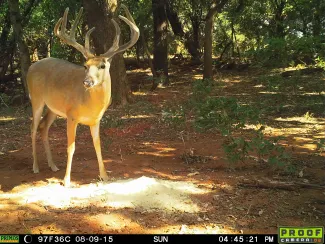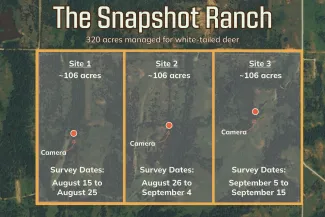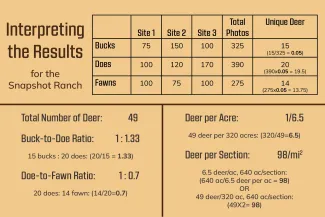Trail cameras are a useful tool for managing white-tailed deer; one of the best tools managers can use to better understand their herd. Done correctly, these surveys can estimate the number of deer per acre, the buck-to-doe ratio, and recruitment. Keep in mind, this survey is designed to establish trends and estimate deer numbers. Trail camera surveys do not provide a complete census of your herd.

Corn is the most readily available bait used for trail camera surveys, but milo and rice bran are less attractive to non-target species.
This survey assumes that:
- Deer on your property are attracted to bait sites.
- The attractiveness of the bait is similar each year.
- Bucks and does are equally attracted to the bait site.
- Every unique buck photographed is identified accurately.
- A majority of deer using the property are photographed.
Surveys can be conducted before or after hunting season. Pre-season surveys start in late summer (mid-August to mid-September) when buck antlers are nearly full grown, and fawns are moving with does. This time of year is best for determining harvest rates for the upcoming season. Another option is to conduct surveys after hunting season to determine how many deer are remaining on the property. This should be done in January, before antlers begin to drop. Combining the surveys can give a picture of what is happening with your deer herd year-round.
Setting Up a Trail Camera Survey
- Make a grid layout across a map or aerial photo of the property. The total acreage will determine the size of each block. We recommend having at least one camera per 100 acres for properties less than 1,000 acres in size. For larger properties, one camera per 160 acres is sufficient. (Cameras can be rotated to different areas to limit the number of cameras needed.) Within each block, select a site near the center of the survey area with ease of access and deer activity in mind (two-track roads, deer trails, etc.). Identify each grid with a number or letter. This ID can be painted on a nearby tree or board in the photo background to help with sorting photos.
- Locate the camera 12 to 20 feet from the bait. Try to center the bait pile in the camera’s field of view. Camera brands have varying effective ranges so check the manufacture’s suggested distances. Set the camera delay for a minimum of 5 minutes to reduce the number of images you have to sort later.
- Run the survey for 10 to 14 days. In research studies, 85% of deer on a property were photographed in 10 days. Ninety percent of deer on a property were photographed in 14 days. When trying to manage expenses, 10 days is sufficient.
- After the survey period, sort your images and count the number of bucks, does, and fawns. Fawns are all deer younger than 1 year old, including buck fawns. Study the photos closely to count the number of unique bucks based on antler characteristics. This will help determine deer density. If you have 100 buck photos and can positively identify 10 individuals, the ratio of unique bucks to total bucks is 10:100, or 10%. This “unique buck ratio” can then be applied to the number of does and fawns recorded. (If 300 images of does are taken, applying the 10% ratio would yield an estimated 30 does (300 X 0.10 = 30 does)
Survey Tips
- Avoid timing your survey when natural food sources (acorns) are readily available.
- Orient your camera in a northern or southern direction to avoid harsh sunlight affecting the photo quality.
- Set your cameras at waist height to get the best photo of the deer.
- Check pictures the day after you install your camera. If no deer were observed, consider pre-baiting the site.
- Consistency is key. Use the same location every year, during the same time period.


Learn how to apply this survey in your deer herd management by contacting a Wildlife Department Private Lands Biologist.